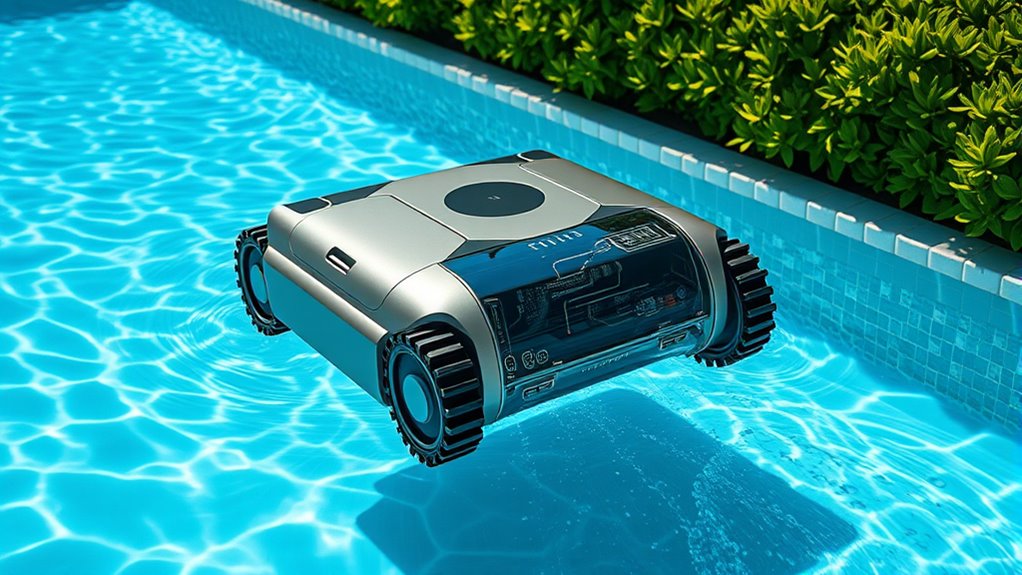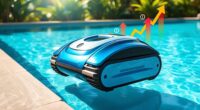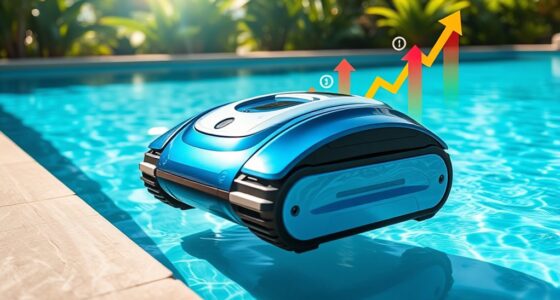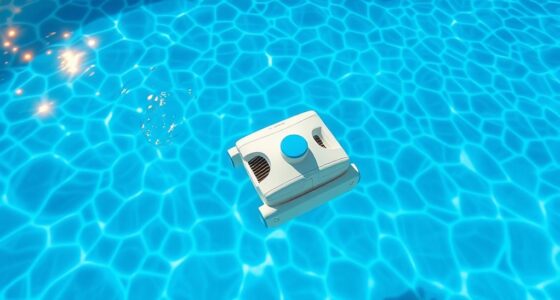AI and smart technology in robotic pool cleaners improve navigation, enabling them to avoid obstacles and cover every inch efficiently. Advanced sensors and real-time data processing help them detect debris, monitor water quality, and adjust routines automatically. These cleaners can connect with smart home systems, allowing you to control them via apps or voice commands. With better energy management and customization options, they make pool maintenance easier and more effective—explore how these features work together for ideal pool care.
Key Takeaways
- AI-powered navigation and sensor systems optimize cleaning routes, obstacle avoidance, and debris detection for efficient pool maintenance.
- Real-time data processing enables instant adjustments to water chemistry, surface analysis, and environmental changes.
- Smart home integration allows remote control, scheduling, and automation via voice commands and mobile apps.
- Advanced sensors monitor water quality continuously, supporting proactive maintenance and optimal chemical balance.
- Eco-friendly features and energy management extend device lifespan, reduce costs, and enhance sustainable pool cleaning.
How AI Enhances Navigation and Cleaning Efficiency
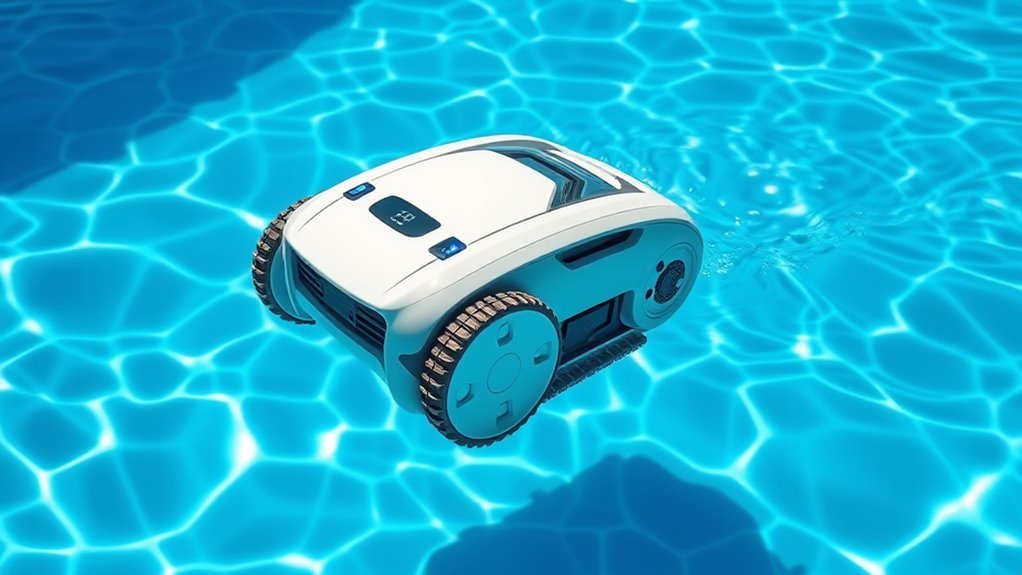
AI remarkably improves how robotic pool cleaners navigate and clean your pool. Instead of relying on basic patterns, AI-powered cleaners analyze your pool’s layout, avoiding obstacles and ensuring thorough coverage. This reduces manual maintenance, saving you time and effort. AI also optimizes cleaning routes, which means less energy and faster results. Plus, intelligent systems can alert you to issues like imbalanced chemical levels, helping you maintain proper chemical balancing without extra effort. This proactive approach minimizes the need for manual interventions, keeping your pool consistently clean and safe. Additionally, integrating smart home technology allows for real-time utility monitoring, making your pool maintenance more comprehensive and connected. Leveraging innovative technologies like AI helps you stay ahead of potential problems, ensuring your pool remains pristine with less effort. Moreover, AI systems can adapt to changing environmental conditions, optimizing cleaning schedules based on usage patterns and weather. For example, understanding pool chemistry can further enhance the effectiveness of cleaning routines. Incorporating AI-driven analytics into your pool care can provide valuable insights for optimizing maintenance routines. Overall, AI-driven navigation makes pool maintenance smarter, easier, and more effective.
Advanced Sensors and Real-Time Data Processing

Advanced sensors are key to improving your robotic pool cleaner’s accuracy, with their precise placement ensuring better detection of debris and surface changes. When combined with instant data analysis, these sensors allow the cleaner to adapt quickly and optimize its cleaning path. This seamless real-time processing makes your pool cleaner more efficient and effective. Additionally, incorporating sensor calibration techniques can further enhance the sensor accuracy and reliability of sensor readings over time. Regular calibration helps maintain optimal sensor performance, especially in changing pool conditions. Moreover, advancements in sensor technology continue to push the boundaries of what robotic cleaners can achieve, providing more comprehensive and efficient cleaning solutions. As automation and data privacy considerations evolve, manufacturers are increasingly focusing on securing user data during operation, which can further improve user confidence and technology adoption.
Sensor Precision and Placement
Since precise sensor placement and high-quality data are crucial for effective cleaning, robotic pool cleaners now incorporate advanced sensors that deliver real-time information about their surroundings. These sensors undergo rigorous sensor calibration to guarantee accurate readings, which directly impacts their placement accuracy on the pool surface. Proper placement allows the robot to detect obstacles, dirt, and water flow more effectively, optimizing cleaning paths. Enhanced sensor precision minimizes errors caused by environmental factors like water debris or reflections, ensuring consistent performance. As a result, your cleaner can adapt quickly to changes in the pool’s layout or debris distribution. Incorporating sensor calibration techniques with advanced sensors can further improve data accuracy and cleaning efficiency. Implementing proper planning based on smart sensor data further enhances the efficiency of the cleaning process. Additionally, considering sensor robustness helps maintain performance in variable pool conditions, ensuring long-term reliability. Leveraging real-time data processing enables the robot to respond instantaneously to environmental changes, leading to smarter cleaning strategies. This integration of advanced sensors with precise calibration and placement accuracy creates a smarter, more efficient cleaning process that saves you time and maintains your pool’s pristine condition.
Instant Data Analysis
With sensors precisely calibrated and well-placed, robotic pool cleaners can now process data instantly as it’s collected. This real-time data analysis transforms pool maintenance by providing immediate insights into water chemistry and cleanliness. Advanced sensors detect pH levels, chlorine concentration, and contaminants without delay, allowing the cleaner to adjust its actions on the spot. You no longer need to wait for manual tests or guesswork; the robot’s AI-driven system makes decisions immediately, ensuring ideal water conditions at all times. This rapid response not only improves water quality but also extends the lifespan of your equipment. Utilizing advanced filtration technology enhances the accuracy of sensor readings and overall cleaning efficiency. Incorporating easy maintenance features can further optimize the performance and longevity of the robotic cleaner. As AI integration continues to evolve, these smart systems are expected to become even more cost-effective and reliable, providing a smarter, more efficient cleaning process that keeps your pool sparkling and balanced effortlessly. Additionally, the integration of tuning and upgrade options from Honda vehicles underscores the broader potential of AI-driven customization and performance optimization across various technologies.
Integration With Smart Home Systems

Integrating robotic pool cleaners with smart home systems allows you to control and monitor your pool effortlessly through a single platform. You can schedule cleanings, receive updates, and activate functions using voice commands, making pool maintenance seamless. Additionally, security integration guarantees your pool area remains safe; sensors can alert you to unauthorized access or abnormalities. Compatibility varies among systems, so check your smart home platform’s options. Here’s a quick overview:
| Feature | Benefits | Compatibility |
|---|---|---|
| Voice Commands | Hands-free control, easy adjustments | Alexa, Google Assistant, Siri |
| Security Integration | Enhanced safety with sensors and alerts | Ring, SimpliSafe, SmartThings |
| Remote Monitoring | Monitor cleaning status remotely | App notifications, dashboards |
| Automation | Scheduled cleaning and security routines | IFTTT, HomeKit, SmartThings |
Adding privacy considerations can help ensure your data remains protected while enjoying smart features.
Energy Efficiency and Battery Management
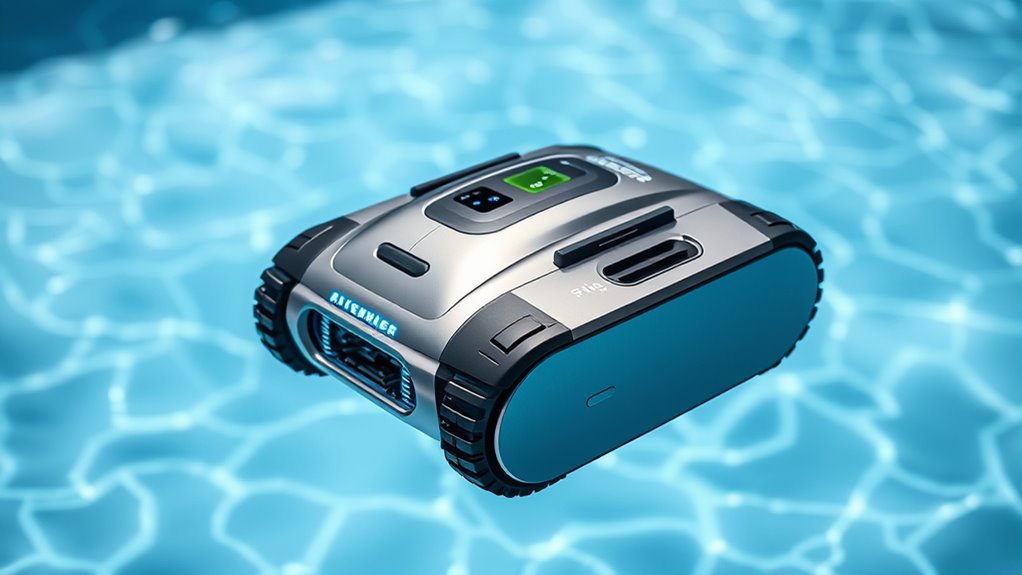
Optimizing energy efficiency and battery management is essential for getting the most out of your robotic pool cleaner. Modern models use AI to intelligently adjust cleaning cycles, conserving power while guaranteeing thorough water filtration. Solar panels can supplement energy needs, reducing reliance on grid power and increasing sustainability. Battery technology has advanced, allowing longer runtimes and faster charging, so your cleaner is ready when you need it. Some cleaners automatically return to their docking station when battery levels are low, maximizing power usage. Efficient energy management not only lowers operating costs but also extends the lifespan of the device. By integrating smart power solutions like solar panels and smart battery systems, you ensure your pool stays clean with minimal energy waste. Additionally, automotive water spot removers incorporate protective coatings that can help maintain clarity and reduce the buildup of debris on pool surfaces, indirectly supporting cleaner efficiency.
User-Friendly Controls and Customization Features
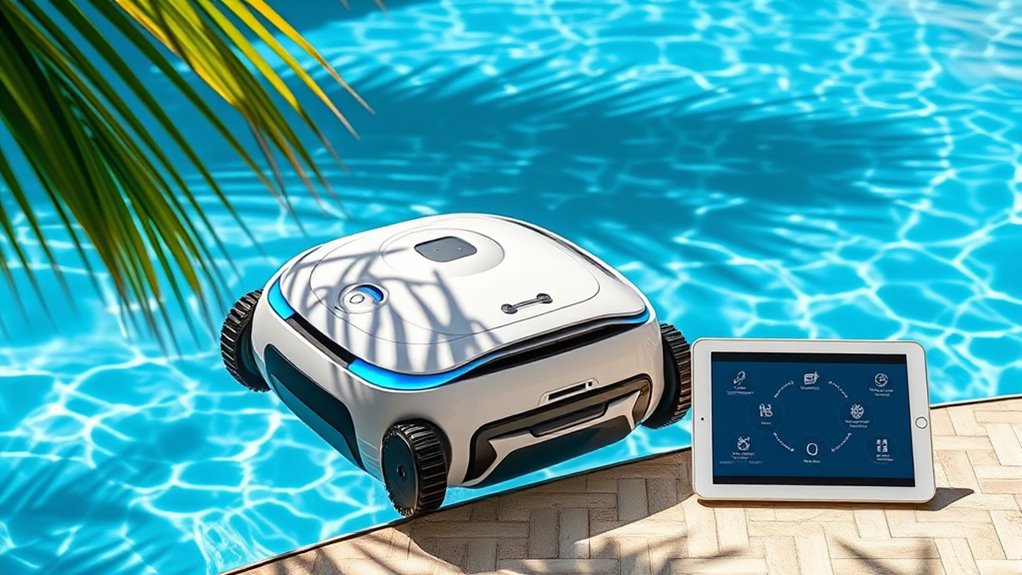
You’ll find that intuitive control interfaces make operating your robotic pool cleaner effortless, even if you’re not tech-savvy. With personalized cleaning modes, you can easily customize the schedule and areas to suit your pool’s needs. These features give you more control and help keep your pool sparkling with minimal effort. Additionally, understanding operating hours of related services can help you plan maintenance and cleaning schedules more effectively.
Intuitive Control Interfaces
Thanks to advancements in AI and smart technology, robotic pool cleaners now feature intuitive control interfaces that make managing your device simple and straightforward. With voice commands, you can start, pause, or adjust cleaning sessions effortlessly, no need to use a remote or app. Touchscreen interfaces provide a user-friendly experience, allowing you to customize cleaning schedules, select specific zones, or check status updates with a few taps. These controls are designed to be responsive and easy to navigate, even for first-time users. The combination of voice activation and intuitive touchscreens ensures you can operate your robotic cleaner quickly and confidently, giving you more time to enjoy your pool rather than fuss with complicated controls.
Personalized Cleaning Modes
Building on the intuitive controls, modern robotic pool cleaners now offer personalized cleaning modes that cater to your specific needs. Thanks to adaptive algorithms, these cleaners learn from your pool’s layout and your preferences, adjusting their cleaning patterns for maximum efficiency. User personalization allows you to select modes tailored to different conditions, such as light maintenance or deep cleaning. You can easily customize cleaning schedules, focusing on areas that need extra attention or avoiding certain zones. This smart feature guarantees your pool gets a thorough clean without wasting time or energy. With these advanced capabilities, you gain greater control and convenience, making pool maintenance simpler and more effective. Personalized cleaning modes enhance your experience by delivering tailored results with minimal effort.
Future Trends in Robotic Pool Cleaning Technology
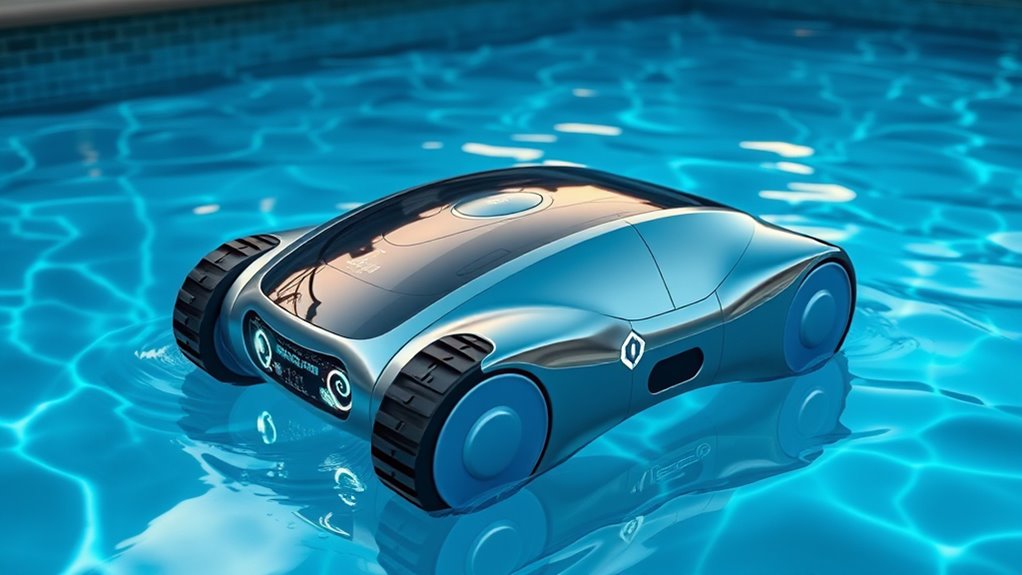
As technology continues to advance, the future of robotic pool cleaning is set to become even smarter and more efficient. You can expect AI-driven systems that optimize pool maintenance by automatically adjusting cleaning routines based on water chemistry and debris levels. These robots will incorporate sensors to monitor water quality continuously, ensuring optimal chemical balance and clarity. Advanced algorithms will enable them to identify areas needing extra attention, reducing manual oversight. Integration with smart home systems will allow you to control and schedule cleanings remotely. Additionally, future models may feature eco-friendly designs that conserve energy and water. Overall, these innovations will make pool maintenance more seamless, saving you time and ensuring your pool stays pristine with minimal effort.
Frequently Asked Questions
How Do AI Algorithms Adapt to Different Pool Shapes and Sizes?
You might wonder how robotic pool cleaners handle various pool shapes and sizes. They use adaptive algorithms that adjust cleaning patterns dynamically, ensuring thorough coverage. Shape recognition helps the cleaner identify obstacles and unique corners, optimizing its route. This combination allows the device to adapt seamlessly to different pools, providing efficient cleaning whether it’s a small, irregularly shaped or large, rectangular pool, making your pool maintenance hassle-free and effective.
What Cybersecurity Measures Protect Smart Robotic Pool Cleaners From Hacking?
Imagine your smart robotic pool cleaner falling prey to hackers—scary, right? That’s why you need strong cybersecurity measures. You should guarantee it uses top-tier encryption protocols to scramble data and prevent unauthorized access. Implement robust access controls, like unique passwords and user authentication, to keep intruders out. These safeguards act like an impenetrable fortress, protecting your device from hacking attempts and keeping your pool cleaning system safe and secure.
Can Ai-Powered Pool Cleaners Identify and Target Specific Types of Debris?
You wonder if AI-powered pool cleaners can identify and target specific debris types. With advanced debris detection, these cleaners analyze the debris in your pool, distinguishing leaves, dirt, or small particles. They then perform targeted cleaning, focusing on areas with more debris for efficient results. This smart technology guarantees thorough cleaning, saving you time and energy, while keeping your pool spotless by focusing on the debris that matters most.
How Do Maintenance Requirements Differ Between Ai-Integrated and Traditional Cleaners?
You’ll find that maintenance needs for AI-integrated cleaners involve regular sensor calibration to guarantee accurate debris detection and navigation, which isn’t necessary for traditional models. Plus, AI cleaners often feature a sophisticated user interface, making setup and troubleshooting easier. In contrast, traditional cleaners require less technical upkeep but might need more manual intervention. Overall, AI models may demand more initial attention but provide more efficient, automated cleaning over time.
Are There Any Environmental Impacts Associated With Smart Pool Cleaning Technologies?
Like Icarus’s fall, concerns about smart pool tech focus on environmental impacts. You might wonder if these devices contribute to chemical runoff or water waste. While they often promote water conservation by optimizing cleaning, some models could inadvertently increase chemical use or waste if not properly maintained. Overall, smart pool cleaners aim to reduce environmental harm, but it’s essential to choose eco-friendly options and maintain them well to minimize negative effects.
Conclusion
With AI and smart tech transforming robotic pool cleaners, you’re stepping into a future where cleaning is effortless and precise. These innovations act like a vigilant dance partner, guiding your cleaner seamlessly through every nook and cranny. As technology advances, expect even smarter, more efficient devices that make maintaining your pool a breeze. Embrace the evolution, and let your pool sparkle with the effortless grace of intelligent automation—making cleaning a rhythm you’ll never want to stop.
